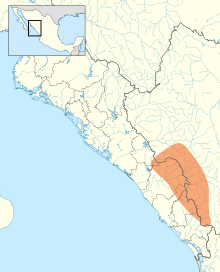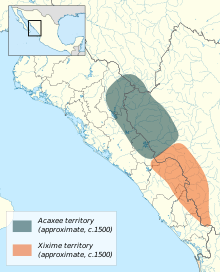Xiximes
The Xixime were an indigenous people who inhabited a portion of the Sierra Madre Occidental mountains in the present day states of Durango and Sinaloa, Mexico.[1][2] The Xixime are noted for their reported practice of cannibalism and resistance to Spanish colonization in the form of the Xixime Rebellion of 1610.[3]
 Xixime territory circa 1500 | |
| Languages | |
|---|---|
| Xixime language |
Language
The Xixime spoke Xixime, a poorly documented, now-extinct Uto-Aztecan language.[4] Dialects of Xixime included Hine and Hume (to the north and south of the Xixime territory, respectively).[5] The exact classification of the language is unknown although it may belong to the Taracahitic branch.[6]
Cannibalism
A considerable amount of the scholarship and media attention devoted to the Xixime has focused on the group's reported practice of cannibalism. While a variety colonial Spanish accounts of the Xixime report the culture engaged in frequent, ritual consumption of enemy peoples, the historical accuracy of the allegations is disputed.[7][8]
A number of historians including Susan M. Deeds apply theories developed by Gananath Obeyesekere on Aztec sacrifice to suggest that the practice of cannibalism was "exaggerated or contrived" by the Xixime to intimidate their Spanish enemies.[3][9]
In 2011 José Luis Punzo argued that newly discovered bones from Cueva del Mague, Durango constituted proof of the practice, citing evidence of "boiling and defleshing."[1]
Relationship with the Spanish
Impressions
Conquistador Nuño de Guzmán first documented the existence of the Xixime via reports collected by scouts during a 1530 expedition.[2] In comparison with their neighbors, the Xiximes were regarded as relatively civilized by the Spanish given their urban settlements and stone buildings.[3]
Xixime Rebellion of 1610

Despite initially tolerating the presence of Spanish missions in neighboring territories, the Xiximes, in 1610, began organizing violent resistance to colonial incursions. The Xiximes solicited help from the Acaxees (their northern neighbors and historical enemies) and Tepehuán arguing that Jesuit churches were "temples of disease" and that destroying them would bring immortality.[10] In response to Acaxee unwillingness to cooperate in anti-Spanish rebellion, the Xiximes began organizing attacks on Acaxee villages.[3]

To fend off the attacks, the Acaxee requested protection from the Spanish. In response, Francisco de Urdiñola attempted to secure peace through diplomatic means, though such efforts were spurned by the Xiximes. Aided by 200 Spanish soldiers and 1,100 indigenous allies, Urdiñola attempted to quell the Acaxee-led. By October, the surrender of key rebel leaders had effectively ended the uprising.[3]
Tepehuán Revolt
The Tepehuán Revolt of 1616, which proved significantly harder to contain than the Xixime Rebellion, enjoyed widespread Xixime support.[11]
References
- "Cannibalism Confirmed Among Ancient Mexican Group". National Geographic News. 2011-10-01. Retrieved 2019-09-06.
- Delgadillo, Sergio (2017). "El proceso de extinción de los acaxees y xiximes" (PDF). gob.mx.
- Schroeder, Susan (1998). Native Resistance and the Pax Colonial in New Spain. U of Nebraska Press. p. 22. ISBN 9780803292499.
- Kroeber, Alfred Louis (1939). Cultural and Natural Areas of Native North America. University of California Press.
- Vogt, Evon Z. (1969-01-01). Handbook of Middle American Indians, Volumes 7 and 8: Ethnology. University of Texas Press. ISBN 9781477306697.
- Campbell, Lyle (2000). American Indian Languages: The Historical Linguistics of Native America. Oxford University Press. ISBN 9780195140507.
- Acosta, Rivera (2017-06-22). Leave us alone, we do not want your help. Let us live our lives : indigenous resistance and ethnogenesis in Nueva Vizcaya (colonial Mexico) (Thesis thesis). University of St Andrews.
- "Sinaloa Xixime people's Cannibalism, A Myth". www.inah.gob.mx. Retrieved 2019-09-07.
- Obeyesekere, Gananath (1997-12-14). The Apotheosis of Captain Cook: European Mythmaking in the Pacific. Princeton University Press. p. 262. ISBN 9780691057521.
- Deeds, Susan M. (2010-01-01). Defiance and Deference in Mexico's Colonial North: Indians under Spanish Rule in Nueva Vizcaya. University of Texas Press. ISBN 9780292782303.
- Griffiths, Nicholas (2017-08-31). Sacred Dialogues: Christianity and Native Religions in the Colonial Americas 1492–1700. Lulu.com. ISBN 9780244019631.